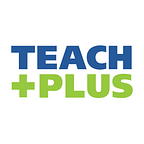Mel Coryell, a Teach Plus Indiana Fellow, an educator with 16 years of experience, school leader, and parent to two teens, has been wearing several hats, many of them new, since teaching went virtual this spring.
A Day of COVID Teaching
Mel started the fall semester fully virtual. Her school then transitioned to a hybrid model for about five weeks, and more recently with an increase in COVID-19 cases, she has gone back to a fully virtual teaching environment.
When Mel teaches, her day is straightforward now that everything has returned to fully virtual again. On the days she doesn’t have classes, Mel assists other educators to switch to not only a virtual learning platform, but also a system for grading and assessing students that makes sense.
“A lot of what I do is trying to support other faculty and finding the best way forward to ensure quality delivery to students,” she said.
The Challenges
Going from teaching virtually to in person was stressful, Mel said, but in some ways, going back to completely virtual from a hybrid system eased some of the stress for her and streamlined the lessons she could teach.
“It was really difficult to teach both online and in person at the same time,” she said.
With her entire class in one location, she can focus her attention on all the students at once and they can do group work more seamlessly.
“There are lots of pressures beyond the awful ones like your students who are not showing up to class and you feel powerless to help them,” she said. “Aside from things like the internet failing and the schedule changing constantly because of things that are outside of our control, there’s still pressure for continuous improvement.”
There’s also the struggle of connecting with the students.
“Our kids don’t turn their cameras on, so I teach to a bunch of circles with initials on them every day,” she said. “We all agreed that we weren’t going to make kids [turn their cameras on] but teaching is so often about connecting with people by making eye contact and checking in on them.”
“When we’re face to face, a student could come in and just by looking at them I would know they’re having a bad day or they’re struggling and I would be able to somewhat privately walk up to them and say, ‘Hey, are you OK?’ In the virtual space, that doesn’t exist.”
The Solutions
Because of the pandemic, Mel’s school was able to get devices for all of the students.
“We had kids who didn’t have what they needed at all, as far as computers just to do their regular work before, who now have computers. In that sense, some of the equity issues needed to be addressed for a long time. It was like the light was shone on them. So that’s been good.”
Despite the complete upheaval COVID-19 has caused and the blending of work and home, personal and professional, Mel has been able to find some positive aspects of the changes: For one, she’s able to protect her time better.
“It is actually less stressful for me than it was before because I have a job where I support adults and students. And so my job when I’m at school is a constant juggling of trying to give people the help they need. I couldn’t have an uninterrupted meeting before.”
She’s also noticed the switch to virtual meetings has allowed more students’ families to get involved in ways they couldn’t before.
“We used to have the principal coffee hour and the same nine families where at least one parent didn’t have to work would show up to them,” she said. “And we would have evening meetings and maybe there were four or five other families that joined for those meetings. But now that we offer all of our family meetings online, we see so much more attendance at those meetings. … So, in that sense, our relationships with the families are a little bit better.”
COVID-19 allowed Mel’s school to make adjustments to the school schedule that benefited students and faculty alike. Mondays and Thursdays are “A” days. Tuesdays and Fridays are “B” days, and Wednesdays are “C” days used for office hours, meetings, planning, and schoolwide assemblies.
“That’s a COVID invention that we actually love,” Melody said. “The ‘C’ day is keeping us alive right now. I don’t know how we would wrangle students, plan courses, or do anything if we were teaching all day, all five days.”
From COVID Solutions to Systemic Changes
As a leader on campus, Mel has been able to weigh in on the professional development offered to teachers, and she’s found that many teachers may be at their limits for more tools and strategies.
“I really think that right now, people cannot handle more new things and that one of the best things we can do as school leaders is manage that noise for them, manage those expectations and say, ‘Hey, you don’t need to use Nearpod.’”
Because of the way COVID has interrupted things, Mel has found that it’s unified her fellow educators, which, in turn, has made teaching better.
“Our teams and our professional learning communities have more room for synchronization within each course than there has ever been… Everybody is on the same page. It was bumpy at first, but we’ve really been able to say this matters because we want kids to know where to go for information and the adults around them have to be able to help them.”
Kathy Pierre is Senior National Coordinator of Communications and Media at Teach Plus.
